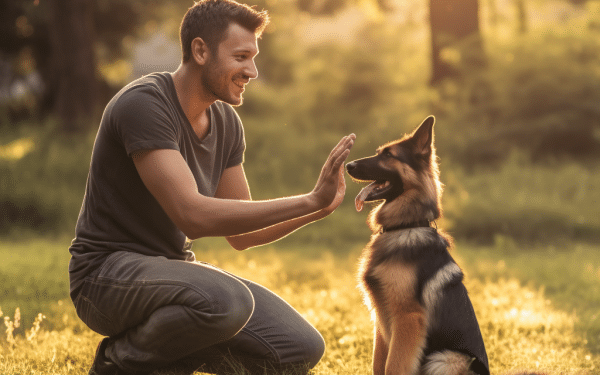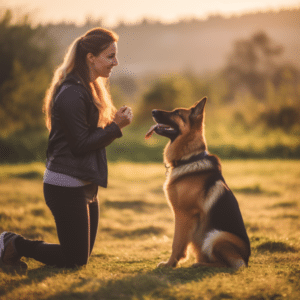Basic Dog Commands: Training, Insurance, and Top Breeds

In order to have a well-behaved dog, it is important to teach them basic commands. Basic Dog Commands are essential in establishing clear communication between the owner and the dog, fostering a strong bond and promoting good behavior. Moreover, a Well-Behaved Dog is more likely to respond appropriately in different environments and situations, making them a joy to have as a companion. In this article, we will explore the importance of basic commands, pet insurance providers that cover training, and the easiest dogs to train. Let’s dive in!
The Importance of Basic Commands for Dogs
Proper training and teaching basic commands are essential for any dog. Basic commands such as “sit,” “stay,” “come,” “off,” and “down” help to establish communication between the owner and the dog. Dogs that have been trained in basic commands are more likely to exhibit good behavior and respond appropriately in different environments and situations. Training a dog in basic commands also helps to build a strong bond between the owner and the pet.
When a dog understands and follows basic commands, it becomes easier for the owner to manage their behavior. For example, the command “sit” can be used to prevent a dog from jumping on people or running out the door. The command “stay” can keep a dog in place while the owner prepares their food or opens the front door. By having a common language through basic commands, owners can effectively communicate their expectations and minimize unnecessary conflicts or misunderstandings.
“Teaching a dog basic commands is not just about obedience; it is about establishing a foundation of trust and understanding. Dogs are social animals that thrive on clear communication and structure. By teaching them the basic commands, we are giving them the tools to navigate the world and be well-behaved companions.”
The Benefits of Basic Commands Training
- Improved behavior: Dogs that have been trained in basic commands are more likely to exhibit good behavior and respond appropriately in different situations.
- Better communication: Teaching basic commands establishes clear communication between the owner and the dog, leading to a stronger bond.
- Enhanced safety: Basic commands help to keep dogs safe by preventing them from engaging in potentially harmful behaviors, such as running into traffic or approaching aggressive dogs.
- Mental stimulation: Training sessions provide mental stimulation for dogs, keeping their minds active and engaged.
- Prevention of behavioral issues: Training a dog in basic commands can prevent the development of behavioral issues, such as aggression or separation anxiety.
Basic Commands
By investing time and effort into teaching basic commands, owners can ensure that their dogs are well-behaved companions that can be taken to various public places without any concerns. Training a dog in basic commands is not only about obedience but also about establishing a foundation of trust and understanding. Dogs are social animals that thrive on clear communication and structure. By teaching them the basic commands, we are giving them the tools to navigate the world and be well-behaved companions.
| Benefits of Basic Commands Training | Description |
|---|---|
| Improved behavior | Dogs that have been trained in basic commands are more likely to exhibit good behavior and respond appropriately in different situations. |
| Better communication | Teaching basic commands establishes clear communication between the owner and the dog, leading to a stronger bond. |
| Enhanced safety | Basic commands help to keep dogs safe by preventing them from engaging in potentially harmful behaviors, such as running into traffic or approaching aggressive dogs. |
| Mental stimulation | Training sessions provide mental stimulation for dogs, keeping their minds active and engaged. |
| Prevention of behavioral issues | Training a dog in basic commands can prevent the development of behavioral issues, such as aggression or separation anxiety. |
Pet Insurance Providers that Cover Training
When it comes to training your dog, having pet insurance that covers behavioral treatment can be incredibly beneficial. There are several pet insurance providers that offer coverage for training, ensuring that you can address any behavioral issues your dog may have. Some of the top pet insurance providers that cover training include:
- Spot Pet Insurance
- Embrace Pet Insurance
- Fetch by The Dodo Pet Insurance
- Trupanion Pet Insurance
- ASPCA Pet Health Insurance
Each of these providers offers coverage for different aspects of behavioral treatment. Spot Pet Insurance, for example, covers training for behavioral issues such as anxiety, aggression, and compulsive behaviors. Embrace Pet Insurance focuses on covering behavioral treatment for things like excessive barking, licking, and aggression. Fetch by The Dodo Pet Insurance covers treatment for changes in temperament, including aggression and anxiety. Trupanion Pet Insurance offers coverage for behavioral issues through their Recovery and Complementary Care add-on. ASPCA Pet Health Insurance covers behavioral training if recommended by a vet and completed by an approved professional.
With these pet insurance providers, you can have peace of mind knowing that if your dog needs training for behavioral issues, the costs will be covered. This allows you to focus on helping your dog become the best-behaved companion possible.
| Pet Insurance Provider | Coverage for Training |
|---|---|
| Spot Pet Insurance | Behavioral issues such as anxiety, aggression, and compulsive behaviors |
| Embrace Pet Insurance | Excessive barking, licking, and aggression |
| Fetch by The Dodo Pet Insurance | Changes in temperament, including aggression and anxiety |
| Trupanion Pet Insurance | Behavioral issues through Recovery and Complementary Care add-on |
| ASPCA Pet Health Insurance | Behavioral training recommended by a vet and completed by an approved professional |
Easiest Dogs to Train
When it comes to training a dog, some breeds are known to be easier to work with than others. These breeds, often celebrated for their high intelligence and willingness to please, are considered highly trainable. Here are some of the easiest dogs to train:
- Border Collies
- German Shepherds
- Papillons
- Labrador Retrievers
- Golden Retrievers
- Border Terriers
- Poodles
- Doberman Pinschers
- Corgis
While these breeds may be easier to train, it’s important to remember that every dog is unique and may require individualized training methods. It’s essential to establish a strong bond with your dog through consistent and positive reinforcement techniques to achieve successful training results.
Training these easy-to-train breeds not only helps them exhibit good behavior but also builds a strong foundation for effective communication between you and your furry friend. With proper training, these dogs are more likely to respond appropriately in different environments and situations, making them a joy to have as companions.
| Breed | Trainability | Temperament |
|---|---|---|
| Border Collies | High | Intelligent, Energetic |
| German Shepherds | High | Versatile, Protective |
| Papillons | High | Intelligent, Playful |
| Labrador Retrievers | High | Friendly, Sociable |
| Golden Retrievers | High | Happy, Obedient |
| Border Terriers | Moderate | Good-Tempered, Affectionate |
| Poodles | High | Intelligent, Athletic |
| Doberman Pinschers | Moderate | Loyal, Brave |
| Corgis | Moderate | Obedient, Loving |
Border Collies: Bright and Energetic
Border Collies are highly intelligent and energetic dogs that are well-known for their exceptional herding abilities. They are often regarded as one of the most intelligent dog breeds due to their quick learning capacity and problem-solving skills. Border Collies thrive in environments where they receive plenty of mental and physical stimulation.
Training a Border Collie should focus on building a strong foundation of basic commands, such as “sit,” “stay,” and “come.” With their natural intelligence and eagerness to please, Border Collies excel in obedience training. However, it is important to provide them with regular exercise and mental challenges to prevent boredom, as they have a tendency to become destructive if not properly stimulated.
When training a Border Collie, it is essential to establish clear boundaries and consistent rules. Positive reinforcement techniques, such as rewards and praise, work best with these bright and energetic dogs. They respond well to training methods that engage their problem-solving abilities and allow them to use their natural herding instincts in a constructive way.
Border Collie Training Tips:
- Provide daily mental and physical exercise to keep your Border Collie stimulated and prevent behavioral issues.
- Use positive reinforcement techniques, such as treats and praise, to motivate and reward your Border Collie during training sessions.
- Engage in interactive games and activities that challenge your Border Collie’s problem-solving skills.
- Establish consistent rules and boundaries to help your Border Collie understand what is expected of them.
- Consider enrolling your Border Collie in advanced obedience classes or agility training to provide additional mental stimulation and challenge.
“Border Collies are highly trainable due to their intelligence and eagerness to please. With the right training methods and consistent boundaries, they can become well-behaved and obedient companions.”
| Characteristics | Description |
|---|---|
| Intelligence | Border Collies are one of the smartest dog breeds, known for their exceptional problem-solving abilities. |
| Energetic | These dogs have high energy levels and require regular exercise and mental stimulation to prevent boredom. |
| Herding Instinct | Border Collies have a strong natural herding instinct and may try to round up people, animals, or objects if not properly trained. |
| Trainability | Due to their intelligence and willingness to please, Border Collies are highly trainable. They excel in obedience training and advanced activities such as agility. |
| Socialization | Early socialization is important to ensure that Border Collies develop appropriate behaviors and interactions with people and other animals. |
German Shepherds: Versatile and Protective
German Shepherds are renowned for their versatility and protective nature. They excel in various roles, including guide dogs, service dogs, watchdogs, and herding dogs. Their intelligence and trainability make them well-suited for these tasks, but early training is crucial to ensure they develop the right behaviors and responses.
When training German Shepherds, it is important to focus on short bursts of time with regular breaks. Their high energy levels require mental and physical stimulation, so incorporating playtime and exercise into their training routine is essential. Positive reinforcement, such as using treats and praise, helps to reinforce desired behaviors and encourages their obedience.
German Shepherds’ protective instinct can sometimes be a challenge to manage, so it’s important for owners to establish themselves as the pack leader early on. Consistency in training and setting clear boundaries will help prevent them from perceiving threats where there are none. With the right training and guidance, German Shepherds can become loyal, well-behaved companions that excel in their assigned roles.
“German Shepherds are known for their loyalty, bravery, and intelligence. With proper training and socialization, they can be versatile and highly dependable dogs.” – Professional Dog Trainer
Training Tips for German Shepherds
- Start training at an early age to establish good behaviors.
- Focus on short, focused training sessions with regular breaks.
- Incorporate mental and physical stimulation into their routine.
- Use positive reinforcement, such as treats and praise, to encourage obedience.
- Establish yourself as the pack leader to manage their protective instinct.
| Training Tips | Benefits |
|---|---|
| Start training at an early age to establish good behaviors. | Builds a foundation for obedience and prevents behavioral issues. |
| Focus on short, focused training sessions with regular breaks. | Helps maintain their attention and prevents mental fatigue. |
| Incorporate mental and physical stimulation into their routine. | Keeps them engaged and satisfied, reducing the likelihood of boredom-based behavior problems. |
| Use positive reinforcement, such as treats and praise, to encourage obedience. | Creates a positive association with training and reinforces desired behaviors. |
| Establish yourself as the pack leader to manage their protective instinct. | Helps create a sense of security, leading to a well-behaved and balanced German Shepherd. |
Papillons: Intelligent and Playful
Papillons are a breed of dog known for their intelligence and playful nature. They are highly trainable, making them a popular choice for owners looking for an active and engaged pet. Their intelligence allows them to quickly pick up new commands and tricks, making training sessions both fun and rewarding.
One of the key attributes of Papillons is their playful nature. They love to engage in various activities, such as playing fetch, solving puzzle toys, and participating in dog sports like agility. These activities not only provide physical exercise but also mental stimulation, which is crucial for their well-being. Training sessions that incorporate playtime and interactive games can help keep Papillons focused and motivated.
To maximize the training potential of Papillons, positive reinforcement techniques should be employed. Rewarding desired behaviors with treats and praise helps reinforce their understanding of commands and encourages them to repeat those behaviors. Consistency and patience are key, as Papillons thrive when given clear instructions and a supportive training environment.
“Papillons are incredibly intelligent and playful dogs. They are always eager to learn and excel in obedience training. Their energy and enthusiasm make training sessions enjoyable for both the owner and the dog. Training a Papillon not only strengthens the bond between the pet and the owner but also ensures a well-behaved and happy companion.”
Training Tips for Papillons
- Start training early: Begin training your Papillon when they are still a puppy to establish good behaviors and habits from the start.
- Keep training sessions short and engaging: Papillons have short attention spans, so break up training into short, focused sessions to keep them interested and prevent boredom.
- Use positive reinforcement: Reward your Papillon with treats, praise, and playtime when they exhibit desired behaviors. This will motivate them to continue to learn and please their owner.
- Be patient and consistent: Training takes time and repetition. Stay calm, be patient, and consistently reinforce the commands you want your Papillon to learn.
- Socialize your Papillon: Exposure to different people, animals, and environments is essential for a well-rounded and confident Papillon. This will help prevent behavior issues and ensure they are comfortable in various situations.
| Training Tips for Papillons |
|---|
| Start training early |
| Keep training sessions short and engaging |
| Use positive reinforcement |
| Be patient and consistent |
| Socialize your Papillon |
Labrador Retrievers: America’s Favorite Family Dogs
Labrador Retrievers are widely known as America’s favorite family dogs. Their friendly and sociable nature, combined with their high trainability, make them ideal companions for households of all sizes. Whether you’re looking for a loyal friend or a playful playmate for your children, Labrador Retrievers fit the bill perfectly.
Training a Labrador Retriever is a rewarding experience that strengthens the bond between you and your pet. These intelligent dogs are quick learners and respond well to positive reinforcement techniques. By using treats, praise, and consistent training methods, you can teach your Labrador Retriever basic commands such as sit, stay, come, and down.
One essential aspect of training Labrador Retrievers is preventing them from picking up or swallowing inappropriate objects. Their curious nature may lead them to explore their surroundings with their mouths, so it’s crucial to create a safe environment and provide them with appropriate chew toys. Regular exercise is also vital to keep their energy levels in check and prevent destructive behavior.
Training Tips for Labrador Retrievers:
- Start training early: Begin training your Labrador Retriever as soon as you bring them home. This will help establish good behavior patterns from the start.
- Be consistent: Use the same commands and techniques consistently to avoid confusion. Labrador Retrievers thrive on routine and clear expectations.
- Use positive reinforcement: Reward your Labrador Retriever with treats, praise, and playtime when they exhibit desired behaviors. This will motivate them to repeat those behaviors in the future.
- Provide mental stimulation: Labrador Retrievers are intelligent dogs that require mental stimulation. Incorporate puzzle toys, obedience training, and interactive games into their daily routine.
- Stay patient and persistent: Training a dog takes time and patience. Be persistent in your efforts and celebrate small achievements along the way.
| Pros of Owning a Labrador Retriever | Cons of Owning a Labrador Retriever |
|---|---|
| 1. Friendly and sociable nature. | 1. High energy levels that require regular exercise. |
| 2. Excellent family dogs and get along well with children. | 2. Can be prone to separation anxiety if left alone for long periods. |
| 3. Adaptable to various living environments. | 3. Shedding can be a concern, requiring regular grooming. |
| 4. Highly trainable and eager to please their owners. | 4. Can be prone to weight gain if not provided with proper exercise and portion control. |
Ultimately, Labrador Retrievers are cherished for their loving and gentle nature. With their trainability and adaptability, they make outstanding family pets. By investing time in training and providing them with adequate exercise and mental stimulation, you’ll have a well-behaved and happy Labrador Retriever by your side.
Golden Retrievers: Happy and Obedient
Golden Retrievers are known for their happy and friendly nature. They are highly trainable and excel in obedience training, making them great candidates for service and therapy work. These intelligent and social dogs thrive on positive reinforcement and respond well to verbal praise and playtime.
Training a Golden Retriever should focus on teaching them basic commands such as “sit,” “stay,” and “come.” Their eager-to-please nature makes them quick learners, and with consistent training and patience, they can become well-behaved and obedient companions. Regular mental and physical exercise is important for their overall well-being and training progress.
Golden Retrievers are also known for their calm demeanor, which makes them excellent family pets. Their gentle and patient nature makes them well-suited for households with children and other pets. However, it is important to supervise interactions with babies and young children due to their size and potential for accidents.
“Golden Retrievers are highly trainable, making them great candidates for service and therapy work.”
Golden Retrievers: Obedience Training Tips
- Start training at an early age to establish good habits and behaviors.
- Use positive reinforcement techniques such as treats, praise, and playtime.
- Be consistent with commands and expectations.
- Focus on teaching basic commands such as “sit,” “stay,” and “come.”
- Provide mental and physical stimulation through regular exercise and interactive toys.
- Enroll in obedience classes or work with a professional trainer for additional guidance.
| Golden Retrievers: Training Tips | Reasoning |
|---|---|
| Start training at an early age | Establishes good habits and behaviors |
| Use positive reinforcement techniques | Encourages desired behaviors and strengthens the bond with the dog |
| Be consistent with commands and expectations | Helps the dog understand what is expected of them |
| Focus on teaching basic commands | Lays the foundation for more advanced training |
| Provide mental and physical stimulation | Prevents boredom and promotes overall well-being |
| Enroll in obedience classes or work with a professional trainer | Offers structured guidance and expertise |
Border Terriers: Good-Tempered and Affectionate
Border Terriers are a breed of dog known for their good temperaments and affectionate nature. They make excellent family pets and are known for their loyalty and love towards their owners. Border Terriers are small to medium-sized dogs with a wiry coat that requires regular grooming. They are intelligent and trainable, which makes them great companions for people of all ages.
These dogs have a natural instinct to please their owners and are eager to learn. They respond well to positive reinforcement training methods and enjoy engaging in mental and physical activities. Border Terriers are highly adaptable and can thrive in both urban and rural environments. They are social dogs and get along well with other pets and children when properly socialized.
“Border Terriers are known for their friendly and easygoing nature. They are affectionate towards their family members and have a playful demeanor. It is important to provide them with regular exercise and mental stimulation to keep them happy and content.” – Dog Trainer
When training a Border Terrier, it is important to be patient and consistent. Establishing a routine and using positive reinforcement techniques such as treats, praise, and playtime will help motivate them during training sessions. Border Terriers excel in activities such as agility, obedience, and scent work. With their good temperament and affectionate nature, they make wonderful therapy dogs as well.
| Characteristics | Description |
|---|---|
| Size | Small to medium-sized dog |
| Temperament | Good-tempered and affectionate |
| Coat | Wiry and weather-resistant |
| Trainability | Intelligent and eager to please |
| Activity Level | Moderate |
| Socialization | Gets along well with other pets and children |
In summary, Border Terriers are good-tempered and affectionate dogs that are easy to train. They thrive on positive reinforcement and enjoy engaging in various activities. With their friendly nature and adaptability, they make wonderful family pets and can bring joy to any household.
Poodles: Intelligent and Athletic
Poodles are highly intelligent and athletic dogs known for their versatility and trainability. Whether in the show ring or participating in dog sports, Poodles excel in various activities that challenge their mental and physical abilities. Their intelligence and eagerness to please make them quick learners, often mastering new tricks and commands with ease.
Due to their athleticism, Poodles require regular exercise to keep them physically fit and mentally stimulated. Activities such as agility training, obedience work, and interactive play sessions are essential for their overall well-being. Puzzle feeding bowls can also provide mental enrichment by stimulating their problem-solving skills.
“Poodles are not only intelligent but also highly intuitive. They have a keen ability to understand their owners’ emotions and respond accordingly,” says Dr. Sarah Johnson, a veterinarian specializing in canine behavior. “Their intelligence combined with their athleticism allows them to excel in various activities, making them a great choice for families or individuals looking for an active and trainable companion.”
Poodle Sizes and Training
Poodles come in three sizes: Standard, Miniature, and Toy. While the training principles remain the same across all sizes, it’s important to adapt the training methods to suit their individual needs. Standard Poodles are larger and more physically active, requiring more rigorous exercise and mental stimulation. Miniature and Toy Poodles may have different exercise requirements due to their smaller size and energy levels.
| Poodle Size | Exercise Needs | Training Considerations |
|---|---|---|
| Standard Poodle | Moderate to high | More physical activities, longer walks or runs |
| Miniature Poodle | Moderate | Structured playtime, shorter walks or runs |
| Toy Poodle | Low to moderate | Gentle exercises, indoor play, short walks |
Regardless of size, positive reinforcement is crucial when training Poodles. Reward-based training methods using treats, praise, and playtime are effective in motivating them to learn and perform desired behaviors. Consistency, patience, and early socialization are key to raising a well-behaved and obedient Poodle.
Doberman Pinschers: Loyal and Brave
Doberman Pinschers are renowned for their loyalty, bravery, and intelligence. These remarkable dogs have a long history of serving in military and police roles, showcasing their exceptional abilities in protection and detection tasks. However, their attributes extend beyond their working capabilities, as they also make excellent pets for families.
Training plays a crucial role in shaping a Doberman Pinscher’s behavior from a young age. By teaching them basic commands and providing consistent guidance, owners can help their Dobermans develop into well-behaved and obedient companions. These dogs require focused attention and regular training sessions to ensure they learn to follow instructions and exhibit calm behavior.
Dobermans are known for their loyalty and bravery, which makes them highly trainable.
Positive reinforcement is a key aspect of training Doberman Pinschers. By using rewards such as treats, praise, and playtime, owners can motivate their dogs and reinforce desired behaviors. Regular exercise is also important to keep Dobermans physically and mentally stimulated, as these dogs thrive on both mental and physical challenges. Through dedication and consistency, owners can help their Doberman Pinschers become well-trained, loyal, and brave companions.
Doberman Pinschers: A Summary of Attributes
| Attribute | Description |
|---|---|
| Loyalty | Doberman Pinschers are incredibly loyal to their owners and form strong bonds. |
| Bravery | These dogs are known for their courage and willingness to protect their loved ones. |
| Intelligence | Dobermans are highly intelligent and quick learners, making them adaptable to various training techniques. |
| Trainability | Their loyalty and intelligence contribute to their trainability, making Dobermans receptive to commands and instructions. |
| Physical Stamina | Doberman Pinschers have excellent endurance and require regular exercise to meet their energy needs. |
With their loyalty, bravery, and intelligence, Doberman Pinschers are exceptional dogs that can be trained to be loyal and obedient companions. Through positive reinforcement, consistent training, and regular exercise, these remarkable dogs can exhibit the qualities that make them highly regarded among dog enthusiasts.
Corgis: Obedient and Loving
Pembroke Welsh Corgis and Cardigan Welsh Corgis are popular breeds known for their obedience and loving nature. These adorable dogs are devoted and make wonderful additions to families. When it comes to training Corgis, it is essential to focus on teaching them basic commands and socializing them with different people and animals. This helps them develop good behavior and adaptability in various situations. However, supervision is important, especially when interacting with babies and young children, due to their small size and the potential for accidents.
Training a Corgi should start early to establish good habits and proper behavior. Basic commands like “sit,” “stay,” and “come” should be taught consistently using positive reinforcement techniques such as treats and praise. Corgis are intelligent and eager to please, making them quick learners. Regular and short training sessions will help keep them engaged and prevent boredom.
The Benefits of Training a Well-Behaved Corgi
Training a Corgi to behave well benefits both the dog and the owner. A well-behaved Corgi is easier to handle and makes daily activities and outings more enjoyable. They obey commands, improving communication and the owner-dog bond. Well-trained Corgis behave well in various situations, allowing them to go to public places without worries.
“Training a Corgi to be well-behaved brings numerous benefits to both the dog and the owner.”
Corgis that have undergone proper training are less likely to exhibit anxiety or fear in new situations. Early socialization helps them become confident and adaptable, reducing the risk of behavioral issues such as aggression or excessive barking. Additionally, regular training and mental stimulation prevent boredom and destructive behaviors, ensuring a happy and fulfilled Corgi.
| Advantages of Training a Corgi |
|---|
| Improved communication between owner and dog |
| Enhanced bond and relationship |
| Good behavior in different environments |
| Confidence and adaptability in new situations |
| Reduced risk of behavioral issues |
| Prevention of boredom and destructive behaviors |
Proper Training and Socialization for Dogs
Proper training and socialization are essential for raising well-behaved dogs. It is important to start training early and focus on teaching basic commands, appropriate behavior, and social skills. By providing clear guidelines and consistent reinforcement, owners can shape their dog’s behavior and establish a strong bond based on trust and understanding.
Training should include positive reinforcement techniques, such as rewards and praise, to encourage desired behavior and discourage negative actions. This approach helps dogs associate obedience and good behavior with positive experiences, making the learning process enjoyable for both the dog and the owner.
Socialization is equally important, as it exposes dogs to different environments, people, and animals, helping them become well-adjusted and adaptable. Introducing dogs to new experiences from a young age prevents fear, anxiety, and aggression in unfamiliar situations. Supervision during interactions with babies and young children is crucial to ensure safety and prevent accidents.
Through training and socialization, owners can cultivate well-behaved, confident dogs suited to diverse environments. These dogs bring joy, companionship, and contribute positively to their community.
The Benefits of Training a Well-Behaved Dog
Training a well-behaved dog has numerous benefits that contribute to a harmonious relationship between the owner and their furry companion. One of the key advantages is the establishment of clear communication. By teaching basic commands and obedience, owners create a language through which they can effectively communicate with their dogs. This leads to a stronger bond and a deeper understanding between the two.
A well-trained dog is more likely to exhibit good behavior in different environments. The ability to follow commands such as “sit,” “stay,” and “come” allows dogs to respond appropriately in various situations. Whether it’s a crowded park, a busy street, or a neighbor’s house, a well-behaved dog will navigate these scenarios with confidence and reliability.
Training also promotes mental stimulation for dogs, preventing behavioral problems that may arise from boredom or frustration. Dogs thrive on mental challenges, and learning new commands and tricks keeps their minds sharp and engaged. Additionally, training reinforces positive behaviors and helps prevent the development of negative habits, such as excessive barking or destructive chewing.
A well-behaved dog is a joy to have as a companion and can be taken to various public places without any concerns. Whether it’s a café, a store, or a family gathering, a trained dog is more likely to be welcome and well-received by others. This level of obedience and socialization opens up opportunities for both the owner and the dog to enjoy new experiences and create lasting memories together.
Table: Benefits of Training a Well-Behaved Dog
| Benefits | Description |
|---|---|
| Clear Communication | Establishes a strong bond between owner and dog through effective communication. |
| Good Behavior | Dogs respond appropriately in different environments, showcasing good behavior. |
| Mental Stimulation | Prevents boredom and behavioral problems by providing mental challenges. |
| Positive Habits | Reinforces positive behavior and prevents the development of negative habits. |
| Public Acceptance | Allows dogs to be welcomed in various public places and social settings. |
Conclusion
Teaching basic commands to a dog is a fundamental aspect of well-behaved dog training. By selecting pet insurance providers that cover training, such as Spot Pet Insurance, Embrace Pet Insurance, Fetch by The Dodo Pet Insurance, Trupanion Pet Insurance, and ASPCA Pet Health Insurance, pet owners can ensure that their dogs receive the necessary behavioral treatment. It is important to note that every dog is unique and may require individualized training methods.
Training a well-behaved dog has numerous benefits. Not only does it establish clear communication between the owner and the dog, but it also strengthens the bond between them. Well-trained dogs are more likely to exhibit good behavior and respond appropriately in different environments and situations. Additionally, training promotes mental stimulation and prevents behavioral issues from arising.
Remember, patience and consistency are key when training a dog. Using positive reinforcement techniques, such as treats and praise, can motivate the dog to learn and behave well. By investing time and effort into teaching basic commands, pet owners can enjoy the companionship of a well-behaved dog that can confidently accompany them to various public places without any concerns.
FAQ
Is teaching basic commands important for having a well-behaved dog?
Yes, teaching basic commands is essential for having a well-behaved dog. It helps with communication and establishes a foundation for good behavior.
Do pet insurance providers cover basic obedience training?
Most pet insurance providers do not cover basic obedience training. However, some may cover behavioral issues and training for anxiety, aggression, and compulsive behaviors.
Can I get reimbursement for training from an approved animal behaviorist?
Yes, if you seek training from an approved animal behaviorist, some pet insurance providers will reimburse you for the expenses. It’s recommended to check with your insurance provider for specific details.
Which dog breeds are easiest to train?
Some of the easiest dogs to train include border collies, German shepherds, poodles, Labrador retrievers, golden retrievers, border terriers, papillons, Doberman pinschers, corgis, and Great Danes. These breeds are known for their intelligence and trainability.
Are Great Danes easy to train?
You should train Great Danes patiently and consistently because of their size and potential for accidents. Training and socializing all dogs, including Great Danes, is crucial.
Should I supervise interactions between a dog and a baby?
Yes, it is essential to supervise interactions between dogs and babies, especially with large breeds like Great Danes. Dogs should always be closely monitored to ensure the safety of both the dog and the baby.








